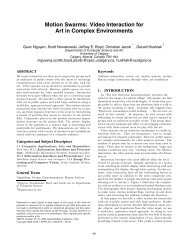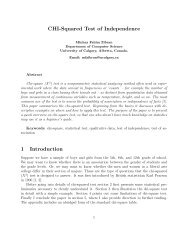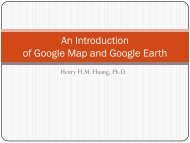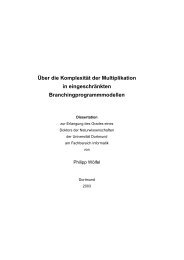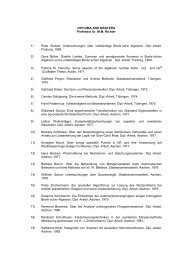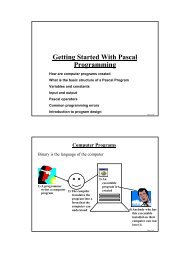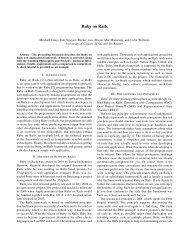Sacrobosco, Johannes.Spaerae mundi.1488.Venice.indd
Sacrobosco, Johannes.Spaerae mundi.1488.Venice.indd
Sacrobosco, Johannes.Spaerae mundi.1488.Venice.indd
You also want an ePaper? Increase the reach of your titles
YUMPU automatically turns print PDFs into web optimized ePapers that Google loves.
From the Tomash Library on the History of Computing<br />
<strong>Sacrobosco</strong>, <strong>Johannes</strong> de; Spæræ mundi co[m]pendiu[m] foeliciter inchoat, 1488, Venice<br />
Spæræ mundi co[m]pendiu[m] foeliciter inchoat<br />
b/w: Peuerbach, George von; Theoricæ novæ planetarum<br />
b/w: Regiomontanus, <strong>Johannes</strong>; Disputationum Johannis de Monte Regio contra Cremonensia in<br />
planetarum theoricas deliramenta præfatio<br />
Notes on this work and its author<br />
Year: 1488<br />
Place: Venice<br />
Publisher: <strong>Johannes</strong> Lucilius Santritter and Hieronymous de Sanctis<br />
Edition: 3rd<br />
Language: Latin<br />
Figures: woodcut frontispiece, full page woodcuts, numerous woodcut diagrams, 8 hand<br />
tinted<br />
Binding: blue morocco by J. & J. Leighton, gilt edges<br />
Pagination: ff. [69]<br />
Collation: A 10 B 8 BB 12 C 8 D 9 E-F 8 G 6<br />
Size: 208x152 mm<br />
Reference:<br />
Gingerich, Owen; Harvard Library Bulletin, v. 19 #2 p. 124.<br />
This volume is the third edition of a work containing all three of the fundamental astronomical works of the era.<br />
The three texts were first printed together in 1482 and again in 1485, 1488 (this volume) and 1490. The allegorical<br />
woodcut frontispiece of Astronomy enthroned between Urania and Ptolemy appears for the first time in this<br />
edition.<br />
<strong>Sacrobosco</strong> (John of Holywood) (ca.1195-1256 [1244?]) is known by various spellings of his name. Little is<br />
known of his origins but it is thought that he was born in Holywood, Yorkshire, England near the end of the<br />
twelfth century and educated at Oxford. About 1220 he went to Paris where he was admitted to the University<br />
in 1221 and shortly thereafter appointed as Professor of Mathematics. By the year 1231, he was considered<br />
to be Europe’s leading mathematician and astronomer. He was a strong advocate of Arabic mathematics and<br />
astronomy. He is known to have written three major works: De Sphaera, De Computo and De Algorismo (and is<br />
thought to have written several more which are now lost). His fame rests mainly on the De Sphaera, based largely<br />
on the works of Ptolemy and Arabic astronomers, written about 1220. De Sphaera became the basic textbook of<br />
astronomy in Europe and was used until well into the seventeenth century. <strong>Sacrobosco</strong>’s other works, although<br />
well regarded, were not as influential as De Sphaera. De Computo, a work on time and the calendar, pointed out<br />
the accumulating errors of the Julian calendar, something that was not rectified for another 350 years. His De<br />
Algorismo is a work on arithmetic. All three of these major works are present in the Tomash Library.<br />
<strong>Sacrobosco</strong> died in Paris in 1256 or 1244, the uncertainty of the date stems from an ambiguous statement quoted<br />
by other authors and once thought to be inscribed on his tomb—1256 is the date usually accepted.<br />
<strong>Sacrobosco</strong>’s Sphera…was the first printed book on astronomy. It provides an exposition of the Ptolemaic world<br />
system and was the most highly regarded astronomical text of medieval times. It had over thirty incunable
From the Tomash Library on the History of Computing<br />
<strong>Sacrobosco</strong>, <strong>Johannes</strong> de; Spæræ mundi co[m]pendiu[m] foeliciter inchoat, 1488, Venice<br />
editions, was published repeatedly in the sixteenth century and was still in common use as a basic text well into<br />
the seventeenth century.<br />
This volume, containing three different works on astronomy, was likely put together as a text for students. The<br />
fact that it was printed in Venice might imply that it was destined for use in the university there, although Venice<br />
was a center for printing and earlier editions of this and similar works had been done there by various printers.<br />
The individual compiling this work decided to include some material that was not present in the traditional<br />
Sphaera manuscripts by <strong>Sacrobosco</strong>, but was likely of use to students in understanding the later material. Notes<br />
on the traditional and added material are included near the relevant page illustration. We have relied on the work<br />
of Lynn Thorndike (The Sphere of <strong>Sacrobosco</strong> and its commentators, 1949) for guidance on what material is<br />
included in earlier manuscripts.<br />
The work by Regiomontanus concerns corrections to the planetary tables of Gerard of Sabbioneta. That of his<br />
mentor and teacher, Georg Peuerbach, is the Theoricæ novæ planetarum…, first published in 1473. All three<br />
authors were highly regarded and these three works functioned for over 150 years as the basic textbooks of pre-<br />
Copernican astronomy.<br />
The works by Regiomontanus and Peuerbach are found in individual files in this collection. The colophon for the<br />
whole volume is at the end of the Peuerbach work.<br />
The marginal notes in this volume are very difficult to read and thus we have not attempted to interpret them.<br />
They presumably comment on, or add to, the text. It is also possible they were made by someone lecturing on the<br />
topic and are essentially reminders of difficult passages that need further explanation.<br />
General notes on the condition of older books<br />
Books as old as this usually suffer from some problems just because of the wear they have been subjected<br />
to over the many years of their existence. One usually noticeable condition item is known as browning or foxing<br />
of the paper - usually brown or yellow areas due to the chemical action of a micro-organism on the paper. This<br />
can vary dramatically from page to page, often depending on such variables as the contents of the paper used, the<br />
composition of the ink used by the printer, and the dampness (or lack of) that the work has been exposed to over<br />
the years. Where these images were badly foxed, some slight manipulation of the intensity of the colors has been<br />
done to ease the reading of the foxed page. Any other notable condition problem will be commented upon near<br />
the image concerned.<br />
Use of these notes and images<br />
This file has been made available by the generosity of Erwin Tomash and the Tomash Library. It is free for<br />
use by any interested individual, providing that no commercial use is made of its contents and any non commercial<br />
use acknowledges the source. The notes and illustrations have been produced by Erwin Tomash and Michael R.<br />
Williams, both of whom beg forgiveness for any errors that they might have made.<br />
© 2009 by Erwin Tomash and Michael R. Williams. All rights reserved.
From the Tomash Library on the History of Computing<br />
<strong>Sacrobosco</strong>, <strong>Johannes</strong> de; Spæræ mundi co[m]pendiu[m] foeliciter inchoat, 1488, Venice<br />
Front cover, spine and rear cover of the volume.
From the Tomash Library on the History of Computing<br />
<strong>Sacrobosco</strong>, <strong>Johannes</strong> de; Spæræ mundi co[m]pendiu[m] foeliciter inchoat, 1488, Venice<br />
The paste-down endpaper contains several labels, the largest being that of the library of Alberto Parreño, a noted<br />
book collector from the middle of the twentieth century.
From the Tomash Library on the History of Computing<br />
<strong>Sacrobosco</strong>, <strong>Johannes</strong> de; Spæræ mundi co[m]pendiu[m] foeliciter inchoat, 1488, Venice<br />
The recto of the first free endpaper contains the ownership signature of William Ivins Jr. (Presumably the well<br />
known curator of prints at the Metropolitan Museum of Art in New York), who evidently acquired this volume<br />
on 23 July 1923.
From the Tomash Library on the History of Computing<br />
<strong>Sacrobosco</strong>, <strong>Johannes</strong> de; Spæræ mundi co[m]pendiu[m] foeliciter inchoat, 1488, Venice<br />
The verso of the first free endpaper.
From the Tomash Library on the History of Computing<br />
<strong>Sacrobosco</strong>, <strong>Johannes</strong> de; Spæræ mundi co[m]pendiu[m] foeliciter inchoat, 1488, Venice<br />
The recto of the second free endpaper.
From the Tomash Library on the History of Computing<br />
<strong>Sacrobosco</strong>, <strong>Johannes</strong> de; Spæræ mundi co[m]pendiu[m] foeliciter inchoat, 1488, Venice<br />
The verso of the second free endpaper.
From the Tomash Library on the History of Computing<br />
<strong>Sacrobosco</strong>, <strong>Johannes</strong> de; Spæræ mundi co[m]pendiu[m] foeliciter inchoat, 1488, Venice<br />
The recto of the page containing the frontispiece.
From the Tomash Library on the History of Computing<br />
<strong>Sacrobosco</strong>, <strong>Johannes</strong> de; Spæræ mundi co[m]pendiu[m] foeliciter inchoat, 1488, Venice<br />
The frontispiece shows Astronomy enthroned and flanked by Urania (the muse of astrology) and Ptolemy. This<br />
same frontispiece, occurring here for the first time, appears in other later editions.
From the Tomash Library on the History of Computing<br />
<strong>Sacrobosco</strong>, <strong>Johannes</strong> de; Spæræ mundi co[m]pendiu[m] foeliciter inchoat, 1488, Venice<br />
The traditional <strong>Sacrobosco</strong> text begins with the large decorated “T” (apparently the same woodcut used by another<br />
in Venice, Erhard Ratdolt, who printed an earlier version of this work in 1485). <strong>Sacrobosco</strong> first describes the<br />
rough contents and then continues to the definition of a sphere (CAPITULUM PRIMUM De DIFFINITIONE<br />
SPAERAE...) but the actual definition waits for several more pages of inserted material.
From the Tomash Library on the History of Computing<br />
<strong>Sacrobosco</strong>, <strong>Johannes</strong> de; Spæræ mundi co[m]pendiu[m] foeliciter inchoat, 1488, Venice
From the Tomash Library on the History of Computing<br />
<strong>Sacrobosco</strong>, <strong>Johannes</strong> de; Spæræ mundi co[m]pendiu[m] foeliciter inchoat, 1488, Venice
From the Tomash Library on the History of Computing<br />
<strong>Sacrobosco</strong>, <strong>Johannes</strong> de; Spæræ mundi co[m]pendiu[m] foeliciter inchoat, 1488, Venice
From the Tomash Library on the History of Computing<br />
<strong>Sacrobosco</strong>, <strong>Johannes</strong> de; Spæræ mundi co[m]pendiu[m] foeliciter inchoat, 1488, Venice
From the Tomash Library on the History of Computing<br />
<strong>Sacrobosco</strong>, <strong>Johannes</strong> de; Spæræ mundi co[m]pendiu[m] foeliciter inchoat, 1488, Venice<br />
Very similar illustrations are found in several other early printed versions. It illustrates the various circles and<br />
points that <strong>Sacrobosco</strong> defines and describes in the first chapter.
From the Tomash Library on the History of Computing<br />
<strong>Sacrobosco</strong>, <strong>Johannes</strong> de; Spæræ mundi co[m]pendiu[m] foeliciter inchoat, 1488, Venice<br />
Here the material briefly returns to the traditional text and defines a sphere (according to Euclid) as a semicircle<br />
that is rotated about the diameter (first diagram) and again (according to Theodosius of Bithynia) as a figure with<br />
a surface equidistant from a central point (second diagram). An axis may be drawn through this central point and<br />
where it intersects the surface will be the poles (third diagram).
From the Tomash Library on the History of Computing<br />
<strong>Sacrobosco</strong>, <strong>Johannes</strong> de; Spæræ mundi co[m]pendiu[m] foeliciter inchoat, 1488, Venice<br />
Beginning with the previous page (De quibusda principiis...) the material on elementary geometry is not in the<br />
traditional text. This additional material continues for another 7 pages. It is undoubtedly the case that some of this<br />
material is relevant to the topic and might have eased later understanding.
From the Tomash Library on the History of Computing<br />
<strong>Sacrobosco</strong>, <strong>Johannes</strong> de; Spæræ mundi co[m]pendiu[m] foeliciter inchoat, 1488, Venice<br />
A continuation of the added material on geometry.
From the Tomash Library on the History of Computing<br />
<strong>Sacrobosco</strong>, <strong>Johannes</strong> de; Spæræ mundi co[m]pendiu[m] foeliciter inchoat, 1488, Venice<br />
A continuation of the added material on geometry.
From the Tomash Library on the History of Computing<br />
<strong>Sacrobosco</strong>, <strong>Johannes</strong> de; Spæræ mundi co[m]pendiu[m] foeliciter inchoat, 1488, Venice<br />
A continuation of the added material on geometry.
From the Tomash Library on the History of Computing<br />
<strong>Sacrobosco</strong>, <strong>Johannes</strong> de; Spæræ mundi co[m]pendiu[m] foeliciter inchoat, 1488, Venice<br />
A continuation of the added material on geometry.
From the Tomash Library on the History of Computing<br />
<strong>Sacrobosco</strong>, <strong>Johannes</strong> de; Spæræ mundi co[m]pendiu[m] foeliciter inchoat, 1488, Venice<br />
A continuation of the added material on geometry.
From the Tomash Library on the History of Computing<br />
<strong>Sacrobosco</strong>, <strong>Johannes</strong> de; Spæræ mundi co[m]pendiu[m] foeliciter inchoat, 1488, Venice<br />
A continuation of the added material on geometry.
From the Tomash Library on the History of Computing<br />
<strong>Sacrobosco</strong>, <strong>Johannes</strong> de; Spæræ mundi co[m]pendiu[m] foeliciter inchoat, 1488, Venice<br />
A continuation of the added material on geometry.
From the Tomash Library on the History of Computing<br />
<strong>Sacrobosco</strong>, <strong>Johannes</strong> de; Spæræ mundi co[m]pendiu[m] foeliciter inchoat, 1488, Venice<br />
Division of the Spheres. <strong>Sacrobosco</strong> describes how the universe is divided into concentric spheres containing the<br />
fixed stars and the planets (including the sun and moon) with the Earth at the center.
From the Tomash Library on the History of Computing<br />
<strong>Sacrobosco</strong>, <strong>Johannes</strong> de; Spæræ mundi co[m]pendiu[m] foeliciter inchoat, 1488, Venice<br />
The second division of the sphere. This comments on the fact that if you lived at the equator your image of the earth<br />
would be as shown in the first diagram—the equator dividing the world in half and the poles being equidistant. If<br />
you lived above or below the equator your view of the Earth and heavens would be different depending on how<br />
close you were to the poles. The four elements are earth, air, fire and water as described by Aristotle.
From the Tomash Library on the History of Computing<br />
<strong>Sacrobosco</strong>, <strong>Johannes</strong> de; Spæræ mundi co[m]pendiu[m] foeliciter inchoat, 1488, Venice<br />
Around the earth (which is changeable) rotate the heavenly spheres (which are unchangeable). The outermost<br />
spheres rotate around the north and south poles while the spheres of the planets rotate about an axis inclined at 23<br />
degrees 32 minutes. He gives the rate of rotation of these inner spheres (Saturn, 30 years; Jupiter, 12 years; Mars,<br />
2 years; sun; 365 days 6 hours, Venus and Mercury, same as the sun; the moon, 28 days 8 hours). The stars rotate<br />
from East to West.
From the Tomash Library on the History of Computing<br />
<strong>Sacrobosco</strong>, <strong>Johannes</strong> de; Spæræ mundi co[m]pendiu[m] foeliciter inchoat, 1488, Venice<br />
The heavenly spheres are spherical because that is the best shape—for a given radius it contains more space than<br />
any other regular figure. He includes a reference to Alfraganus (a western corruption of the name al-Farghani,<br />
an astronomer from the 9th century) who developed an explanation why the sky could not be flat but must be<br />
spherical.
From the Tomash Library on the History of Computing<br />
<strong>Sacrobosco</strong>, <strong>Johannes</strong> de; Spæræ mundi co[m]pendiu[m] foeliciter inchoat, 1488, Venice<br />
The earth is spherical. <strong>Sacrobosco</strong> proves that the earth is a sphere by reference to sunrise and sunset being at<br />
different times in different places (east verses west). He further notes that those living at different latitudes see<br />
different stars and that the only cause of this has to be a spherical earth.
From the Tomash Library on the History of Computing<br />
<strong>Sacrobosco</strong>, <strong>Johannes</strong> de; Spæræ mundi co[m]pendiu[m] foeliciter inchoat, 1488, Venice<br />
The ocean is also a sphere. He notes that people on the top of a ship’s mast can see a signal while those on the deck<br />
can not and that the only cause for this must be that the oceans are part of the sphere of the earth.<br />
The earth is in the middle of the celestial spheres. Because the stars appear to be of equal size in any part of the<br />
sky, people must be equally distant from them all, thus the earth is in the middle of the celestial spheres.
From the Tomash Library on the History of Computing<br />
<strong>Sacrobosco</strong>, <strong>Johannes</strong> de; Spæræ mundi co[m]pendiu[m] foeliciter inchoat, 1488, Venice<br />
The earth does not move. This is justified by noting that all heavy things tend to drop to the lowest point and the<br />
earth being heavy must therefore occupy the central point in the system of the heavenly spheres and stay there.<br />
The second section calculates the size of the earth by noting that ancients (e.g., Eratosthenes) measured it as<br />
252,000 stadia in diameter. Estimates vary, but one widely accepted value is 1 stadion = 607 feet which would<br />
make the circumference of the earth about 29,000 miles (modern measurements make it 25,000 miles)
From the Tomash Library on the History of Computing<br />
<strong>Sacrobosco</strong>, <strong>Johannes</strong> de; Spæræ mundi co[m]pendiu[m] foeliciter inchoat, 1488, Venice<br />
Chapter Two (began on the previous page at CAPITULUM SECUNDUDE) describes the circles. He first mentions<br />
the equator as a circle equidistant from the two poles. He ends with a quote from Virgil that essentially says one<br />
pole is always above us and the other under our feet.<br />
The circle of the zodiac. There is another circle (the zodiac) on an angle to the equator.
From the Tomash Library on the History of Computing<br />
<strong>Sacrobosco</strong>, <strong>Johannes</strong> de; Spæræ mundi co[m]pendiu[m] foeliciter inchoat, 1488, Venice<br />
The zodiac circle is divided into 12 signs. Each sign is divided into 30 degrees, each of which is divided into 60<br />
minutes. All other circles are simply lines, but the zodiac is a band 12 degrees wide. The line dividing the zodiac<br />
through the middle (so 6 degrees are in the north and 6 in the south) is the ecliptic (called this because when both<br />
the sun and moon are on the ecliptic an eclipse can take place).
From the Tomash Library on the History of Computing<br />
<strong>Sacrobosco</strong>, <strong>Johannes</strong> de; Spæræ mundi co[m]pendiu[m] foeliciter inchoat, 1488, Venice<br />
A sign of the zodiac can be thought of as a volume like a pyramid with a point at the center of the earth and the<br />
base being the 12 by 30 degree area of the zodiac for this sign. This volume may extend to the outer spheres so<br />
that various astronomical objects can be designated as being in a particular sign.<br />
The colure circles. There are two colure circles, one called the solstitial colure and the other the equinoctial<br />
colure.
From the Tomash Library on the History of Computing<br />
<strong>Sacrobosco</strong>, <strong>Johannes</strong> de; Spæræ mundi co[m]pendiu[m] foeliciter inchoat, 1488, Venice<br />
The solstitial colure intersects the poles of the universe and the poles of the zodiac and passes through he first part<br />
of Cancer and Capricorn. When the sun is in these signs it is the furthest north and south that it is in the year (i.e.,<br />
the summer and winter solstice points). The equinoctial colure is similar, passing through Aires and Libra and the<br />
sun is in these signs at the equinox - equal length of day and night.
From the Tomash Library on the History of Computing<br />
<strong>Sacrobosco</strong>, <strong>Johannes</strong> de; Spæræ mundi co[m]pendiu[m] foeliciter inchoat, 1488, Venice<br />
The meridian and horizon circles (starting on the last page). The meridian is the circle passing directly above an<br />
observer—at noon the sun is on the meridian. The horizon line has its pole in the zenith above the observer’s<br />
head.<br />
The four minor circles. These are the Tropic of Cancer, the Tropic of Capricorn, the Arctic and Antarctic Circles.
From the Tomash Library on the History of Computing<br />
<strong>Sacrobosco</strong>, <strong>Johannes</strong> de; Spæræ mundi co[m]pendiu[m] foeliciter inchoat, 1488, Venice<br />
Ptolemy indicates that the maximum declination of the sun is 23 degrees 51 minutes, so the same measure is the<br />
distance from the arctic circle to the pole. Double that arc is about 48 degrees so, when that is subtracted from 90<br />
degrees the remainder is the arc between the first point of Cancer and the Arctic circle, i.e., 42 degrees.
From the Tomash Library on the History of Computing<br />
<strong>Sacrobosco</strong>, <strong>Johannes</strong> de; Spæræ mundi co[m]pendiu[m] foeliciter inchoat, 1488, Venice<br />
The area of the earth between the two tropics is uninhabitable because the sun is too hot there and the same is true<br />
of the areas between the Arctic Circle and the pole (and Antarctic Circle and the pole) because it is too cold. The<br />
last diagram shows this graphically (human habitation is only shown in half the earth).
From the Tomash Library on the History of Computing<br />
<strong>Sacrobosco</strong>, <strong>Johannes</strong> de; Spæræ mundi co[m]pendiu[m] foeliciter inchoat, 1488, Venice<br />
The material on this page appears not to be part of the traditional <strong>Sacrobosco</strong> text.
From the Tomash Library on the History of Computing<br />
<strong>Sacrobosco</strong>, <strong>Johannes</strong> de; Spæræ mundi co[m]pendiu[m] foeliciter inchoat, 1488, Venice<br />
The material on this page appears not to be part of the traditional <strong>Sacrobosco</strong> text.
From the Tomash Library on the History of Computing<br />
<strong>Sacrobosco</strong>, <strong>Johannes</strong> de; Spæræ mundi co[m]pendiu[m] foeliciter inchoat, 1488, Venice<br />
The material on this page appears not to be part of the traditional <strong>Sacrobosco</strong> text.
From the Tomash Library on the History of Computing<br />
<strong>Sacrobosco</strong>, <strong>Johannes</strong> de; Spæræ mundi co[m]pendiu[m] foeliciter inchoat, 1488, Venice<br />
The material on this page appears not to be part of the traditional <strong>Sacrobosco</strong> text.
From the Tomash Library on the History of Computing<br />
<strong>Sacrobosco</strong>, <strong>Johannes</strong> de; Spæræ mundi co[m]pendiu[m] foeliciter inchoat, 1488, Venice<br />
The material on this page appears not to be part of the traditional <strong>Sacrobosco</strong> text.
From the Tomash Library on the History of Computing<br />
<strong>Sacrobosco</strong>, <strong>Johannes</strong> de; Spæræ mundi co[m]pendiu[m] foeliciter inchoat, 1488, Venice<br />
The material on this page appears not to be part of the traditional <strong>Sacrobosco</strong> text.
From the Tomash Library on the History of Computing<br />
<strong>Sacrobosco</strong>, <strong>Johannes</strong> de; Spæræ mundi co[m]pendiu[m] foeliciter inchoat, 1488, Venice<br />
The material on this page appears not to be part of the traditional <strong>Sacrobosco</strong> text.
From the Tomash Library on the History of Computing<br />
<strong>Sacrobosco</strong>, <strong>Johannes</strong> de; Spæræ mundi co[m]pendiu[m] foeliciter inchoat, 1488, Venice<br />
The material on this page appears not to be part of the traditional <strong>Sacrobosco</strong> text.
From the Tomash Library on the History of Computing<br />
<strong>Sacrobosco</strong>, <strong>Johannes</strong> de; Spæræ mundi co[m]pendiu[m] foeliciter inchoat, 1488, Venice<br />
The traditional <strong>Sacrobosco</strong> material restarts here with Chapter Three (the rising and setting of the heavenly<br />
bodies). He often quotes lines from poems by Vergil (Georgics), Ovid (Fasti and Pontis) when attempting to<br />
illustrate various signs and the seasons related to them.
From the Tomash Library on the History of Computing<br />
<strong>Sacrobosco</strong>, <strong>Johannes</strong> de; Spæræ mundi co[m]pendiu[m] foeliciter inchoat, 1488, Venice<br />
This section describes the rising and setting of the signs of the Zodiac.
From the Tomash Library on the History of Computing<br />
<strong>Sacrobosco</strong>, <strong>Johannes</strong> de; Spæræ mundi co[m]pendiu[m] foeliciter inchoat, 1488, Venice
From the Tomash Library on the History of Computing<br />
<strong>Sacrobosco</strong>, <strong>Johannes</strong> de; Spæræ mundi co[m]pendiu[m] foeliciter inchoat, 1488, Venice<br />
This section concerns the movement of the sun.
From the Tomash Library on the History of Computing<br />
<strong>Sacrobosco</strong>, <strong>Johannes</strong> de; Spæræ mundi co[m]pendiu[m] foeliciter inchoat, 1488, Venice<br />
Here <strong>Sacrobosco</strong> describes how the sun moves through 182 circles (actually a spiral, but he says they are so close<br />
to being a circle that it makes no difference) when traversing from the equator to the tropics. Each of the these<br />
circles represents a single day.
From the Tomash Library on the History of Computing<br />
<strong>Sacrobosco</strong>, <strong>Johannes</strong> de; Spæræ mundi co[m]pendiu[m] foeliciter inchoat, 1488, Venice<br />
The last part of this page is, again, added material that is not normally thought of as part of the traditional work.
From the Tomash Library on the History of Computing<br />
<strong>Sacrobosco</strong>, <strong>Johannes</strong> de; Spæræ mundi co[m]pendiu[m] foeliciter inchoat, 1488, Venice<br />
A continuation of the added material.
From the Tomash Library on the History of Computing<br />
<strong>Sacrobosco</strong>, <strong>Johannes</strong> de; Spæræ mundi co[m]pendiu[m] foeliciter inchoat, 1488, Venice<br />
A continuation of the added material.
From the Tomash Library on the History of Computing<br />
<strong>Sacrobosco</strong>, <strong>Johannes</strong> de; Spæræ mundi co[m]pendiu[m] foeliciter inchoat, 1488, Venice<br />
A continuation of the added material.
From the Tomash Library on the History of Computing<br />
<strong>Sacrobosco</strong>, <strong>Johannes</strong> de; Spæræ mundi co[m]pendiu[m] foeliciter inchoat, 1488, Venice<br />
A continuation of the added material.
From the Tomash Library on the History of Computing<br />
<strong>Sacrobosco</strong>, <strong>Johannes</strong> de; Spæræ mundi co[m]pendiu[m] foeliciter inchoat, 1488, Venice<br />
This begins a section in which <strong>Sacrobosco</strong> comments on how people in various parts of the world would experience<br />
the heavens, climate, etc. While he earlier indicated that the tropical and arctic areas were uninhabitable, he now<br />
indicates that the inhabitants of the equator have no real seasons and again quotes Alfraganus to back up his<br />
statements.
From the Tomash Library on the History of Computing<br />
<strong>Sacrobosco</strong>, <strong>Johannes</strong> de; Spæræ mundi co[m]pendiu[m] foeliciter inchoat, 1488, Venice<br />
For those people living between the equator and the Tropic of Cancer he says that the shadows cast by the sun<br />
are sometimes to the north and sometimes to the south, unlike in higher latitudes where shadows always point<br />
north. He also notes that if one lived on the Tropic of Cancer (he indicates that the city of Syene, modern Aswan<br />
in Egypt, is so situated—almost, but not quite, correct) then one day each year, for one hour, the shadows are<br />
perpendicular.
From the Tomash Library on the History of Computing<br />
<strong>Sacrobosco</strong>, <strong>Johannes</strong> de; Spæræ mundi co[m]pendiu[m] foeliciter inchoat, 1488, Venice<br />
For people living between the Tropic of Cancer and the Arctic Circle the sun always casts a shadow to the north.<br />
He quotes a few lines from the roman poet Marcus Annaeus Lucanus (better known as Lucan) saying that part<br />
of Ethiopia is north of the Tropic of Cancer and how this relates to the sign of Torus. People at the Arctic Circle<br />
experience a day of 24 hours and similarly a night of 24 hours each year.
From the Tomash Library on the History of Computing<br />
<strong>Sacrobosco</strong>, <strong>Johannes</strong> de; Spæræ mundi co[m]pendiu[m] foeliciter inchoat, 1488, Venice<br />
Between the Arctic Circle and the North Pole the inhabitants experience periods of continuous daylight and<br />
continuous night. The length of each depends on how close they are to the Pole.<br />
At the North Pole there will be six months of daylight and six months of night.
From the Tomash Library on the History of Computing<br />
<strong>Sacrobosco</strong>, <strong>Johannes</strong> de; Spæræ mundi co[m]pendiu[m] foeliciter inchoat, 1488, Venice<br />
Take the habitable parts of the Earth (excluding the tropics and the Arctic and Antarctic) and divide this by six<br />
lines parallel to the equator to give seven regions or climates. Such a division is shown by the figure on the next<br />
page (note that north is often shown in the lower portion of the diagrams in this volume).
From the Tomash Library on the History of Computing<br />
<strong>Sacrobosco</strong>, <strong>Johannes</strong> de; Spæræ mundi co[m]pendiu[m] foeliciter inchoat, 1488, Venice<br />
In the middle of the first climate the day is 13 hours long. This climate extends from 16 degrees to 20 degrees 30<br />
minutes and is 440 miles wide (this is actually on the top of the next page).
From the Tomash Library on the History of Computing<br />
<strong>Sacrobosco</strong>, <strong>Johannes</strong> de; Spæræ mundi co[m]pendiu[m] foeliciter inchoat, 1488, Venice<br />
The second climate is where, in the middle, the longest day is 13 hours and extends to 27 degrees 30 minutes, a<br />
distance of 400 miles. Third climate extends to 33 degrees 40 minutes (note the later correction in Hindu-Arabic<br />
numerals from 330 to 33). He continues to define the various climates: fourth extends to 39 degrees; fifth to 43<br />
degrees 30 minutes; sixth to 47 degrees 15 minutes; seventh to 50 degrees 30 minutes. The correction “20” seems<br />
to be an error as the text is correct at this point.
From the Tomash Library on the History of Computing<br />
<strong>Sacrobosco</strong>, <strong>Johannes</strong> de; Spæræ mundi co[m]pendiu[m] foeliciter inchoat, 1488, Venice<br />
The correction “i45” (presumably indicating 145) seems to be an error as the text is correct in stating 185.<br />
Chapter four: the circles and motion of the planets and the cause of solar and lunar eclipses.
From the Tomash Library on the History of Computing<br />
<strong>Sacrobosco</strong>, <strong>Johannes</strong> de; Spæræ mundi co[m]pendiu[m] foeliciter inchoat, 1488, Venice<br />
He states that the sun moves through the zodiac in 365.25 days, except for a small error which is unnoticeable.<br />
Note the printing error here where (on line 8) it states 363 (ccclxiii)—earlier manuscripts have the correct number.<br />
Every planet, other than the sun, have three circles: the deferent (main circular orbit), the epicycle (small circle<br />
centered on the deferent) and the equant (circle centered near the earth)—see lower diagram of the moons motions<br />
which shows the centers of the deferent and equant.
From the Tomash Library on the History of Computing<br />
<strong>Sacrobosco</strong>, <strong>Johannes</strong> de; Spæræ mundi co[m]pendiu[m] foeliciter inchoat, 1488, Venice<br />
He begins a section on the eclipses of the moon (De eclipsi lunae) just below the diagram.
From the Tomash Library on the History of Computing<br />
<strong>Sacrobosco</strong>, <strong>Johannes</strong> de; Spæræ mundi co[m]pendiu[m] foeliciter inchoat, 1488, Venice<br />
Diagrams showing the eclipses of the moon and the sun.<br />
While this is the end of Spæræ mundi, this volume continues with the works by <strong>Johannes</strong> Regiomontanus<br />
(Disputationum) and George Peuerbach (Theoricæ novæ planetarum) which can be found on other files in this<br />
collection of full scans from the Tomash Library. The colophon and printer’s mark for the entire volume is on the<br />
last page of the Peuerbach work.



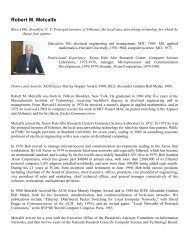
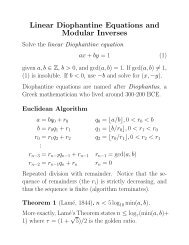

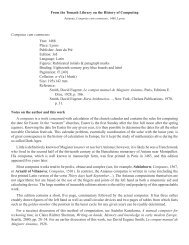
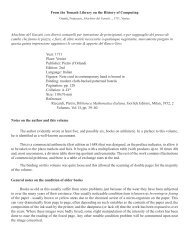
![Alfontii regis castelle illustrissimi celestiu[m]](https://img.yumpu.com/15135040/1/190x245/alfontii-regis-castelle-illustrissimi-celestium.jpg?quality=85)
